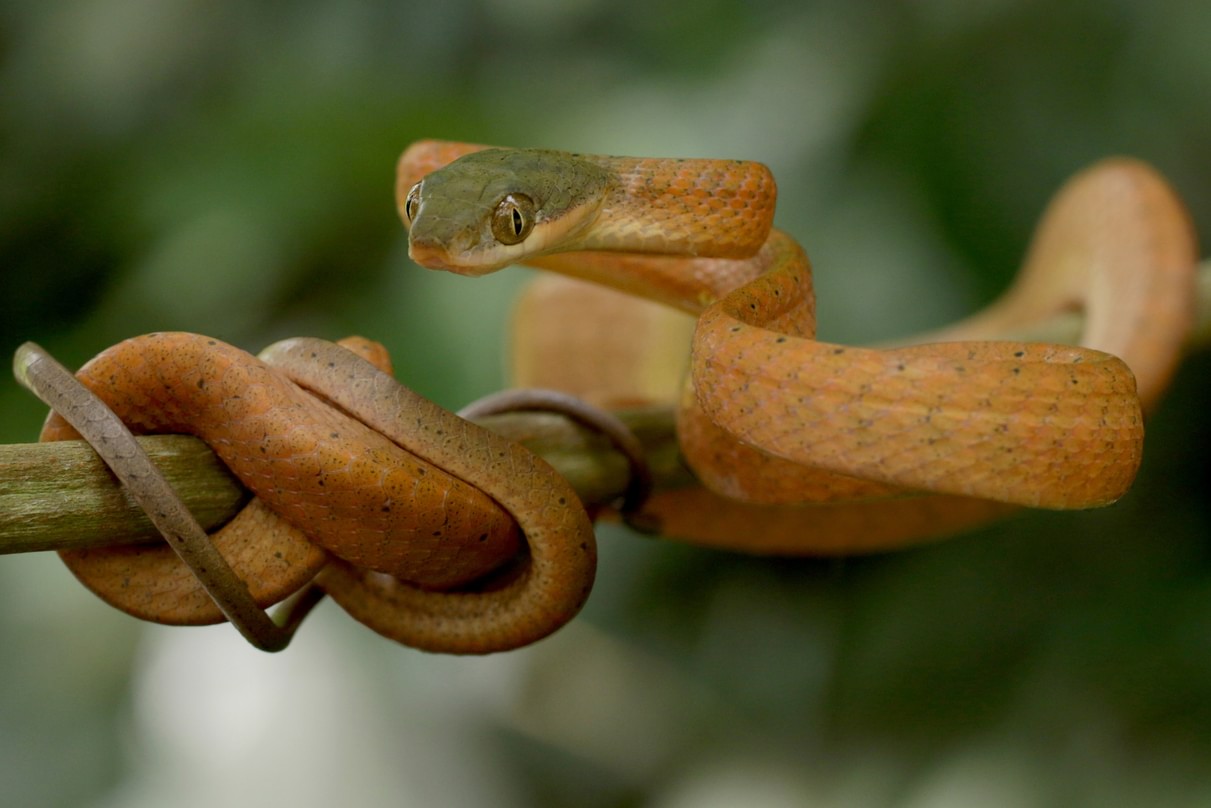
The Black-headed Cat Snake, also known as the Boiga nigriceps, is a fascinating species of snake that captivates with its unique features and behaviors. Found in various parts of Southeast Asia, including Indonesia, Malaysia, and Thailand, this snake possesses an undeniable allure for both reptile enthusiasts and casual observers alike.
In this article, we will delve deep into the world of the Black-headed Cat Snake and explore 17 astonishing facts about this remarkable creature. From its distinct physical characteristics to its hunting techniques and habitat preferences, we will uncover intriguing details about this snake that may surprise you.
Join us on this educational journey as we unravel the mysteries surrounding the Black-headed Cat Snake and gain a deeper appreciation for the diversity of the animal kingdom.
Key Takeaways:
- The Black-headed Cat Snake is a stealthy, arboreal predator with impressive climbing and swimming abilities. Its vibrant colors and long lifespan make it a captivating creature of the tropical rainforests.
- These snakes are skilled hunters with a diverse diet, mild venom, and intricate mating rituals. While not endangered, conservation efforts are crucial to protect their habitat and populations from threats like habitat loss and illegal pet trade.
Stealthy hunters
The Black-headed Cat Snake, also known as Boiga dendrophila, is a fascinating and stealthy member of the snake family. Its sleek black head and vibrant scales make it a stunning creature to behold.
Arboreal dwellers
This species of snake is mainly arboreal, meaning it spends most of its time in trees. Its slender body and strong, grasping tail allow it to effortlessly maneuver through the dense foliage.
Lengthy reptiles
The Black-headed Cat Snake can reach an impressive length of up to six feet, making it one of the larger snake species found in its habitat.
Active at night
These snakes are primarily nocturnal creatures, hunting under the cover of darkness. Their excellent night vision enables them to locate and capture their prey with precision.
Impressive climbing skills
Due to their arboreal nature, Black-headed Cat Snakes have remarkable climbing abilities. They can scale trees using a combination of strong muscles and specialized scales on their belly known as ventral scales.
Prey preference
These snakes have a diverse diet, feeding on a variety of small animals including birds, lizards, rodents, and even bats. They are opportunistic hunters and will take advantage of any suitable prey in their habitat.
Venomous predators
The Black-headed Cat Snake is mildly venomous. While its venom is not considered dangerous to humans, it immobilizes its prey and aids in digestion.
Defensive behavior
When threatened, these snakes may flatten their bodies, hiss loudly, and strike if necessary to deter potential predators. They are generally non-aggressive towards humans unless provoked.
Range of distribution
The Black-headed Cat Snake is native to Southeast Asia, including countries such as Thailand, Malaysia, Indonesia, and Singapore. It primarily resides in tropical rainforests and other densely vegetated areas.
Camouflage masters
With their black head and vibrant scales, Black-headed Cat Snakes possess excellent camouflage. This allows them to blend seamlessly into their forest surroundings, making them difficult to spot.
Egg-laying species
Like many other snake species, the Black-headed Cat Snake is oviparous, meaning it lays eggs. After breeding, the female will find a suitable location to deposit her eggs, and she does not provide any parental care beyond that.
Vibrant coloration
The body scales of the Black-headed Cat Snake can exhibit a wide range of colors, including various shades of green, yellow, orange, or brown. This vibrant coloration adds to their aesthetic appeal.
Excellent swimmers
Despite being mainly arboreal, these snakes are also adept swimmers. They can navigate through bodies of water using their muscular bodies and flattened ventral scales.
Long lifespan
The Black-headed Cat Snake has a relatively long lifespan, with some individuals living for over 20 years in captivity. In the wild, their lifespan may vary depending on factors such as predation and habitat conditions.
Intricate mating rituals
During the mating season, male Black-headed Cat Snakes engage in elaborate courtship rituals to attract females. These rituals often involve displaying their vibrant colors and engaging in graceful movements.
Documentary appearance
These snakes have been featured in several nature documentaries, highlighting their unique behaviors and adaptations. Their striking appearance and intriguing lifestyle make them captivating subjects for filmmakers and wildlife enthusiasts.
Conservation status
The Black-headed Cat Snake is currently not considered to be threatened or endangered. However, habitat loss and illegal pet trade pose potential risks to their populations. Continued conservation efforts are essential to ensure their long-term survival.
Conclusion
The Black-headed Cat Snake is a fascinating creature with a range of astonishing facts. From its unique appearance to its venomous nature, this snake is a true marvel of the animal kingdom. Its ability to climb trees, its preference for higher elevations, and its exceptional hunting skills make it a formidable predator in its habitat.Learning about these facts not only enhances our understanding of this remarkable species but also helps us appreciate the diversity of the animal world. The Black-headed Cat Snake serves as a reminder that there is still much to discover and appreciate about the creatures we share this planet with.
FAQs
Q: What is the scientific name of the Black-headed Cat Snake?
A: The scientific name of the Black-headed Cat Snake is Boiga nigriceps.
Q: Where is the Black-headed Cat Snake commonly found?
A: The Black-headed Cat Snake is commonly found in Southeast Asia, including countries like Thailand, Malaysia, and Indonesia.
Q: Is the Black-headed Cat Snake venomous?
A: Yes, the Black-headed Cat Snake is venomous. However, its venom is not considered to be highly dangerous to humans.
Q: What does the Black-headed Cat Snake eat?
A: The Black-headed Cat Snake primarily feeds on birds, lizards, and small mammals.
Q: How big can the Black-headed Cat Snake grow?
A: The Black-headed Cat Snake can reach lengths of up to 3-4 feet (90-120 cm).
Q: Can the Black-headed Cat Snake climb trees?
A: Yes, the Black-headed Cat Snake is an excellent climber and often utilizes trees as a means of navigation and hunting.
Q: Does the Black-headed Cat Snake have any predators?
A: Although there is limited information on its predators, larger snakes and birds of prey are known to prey upon the Black-headed Cat Snake.
Q: How does the Black-headed Cat Snake defend itself?
A: When threatened, the Black-headed Cat Snake may raise its body to appear larger or rely on its venom as a means of defense.
Q: What is the lifespan of a Black-headed Cat Snake?
A: The exact lifespan of a Black-headed Cat Snake is not well-documented, but it is estimated to be around 15-20 years in captivity.
Q: Is the Black-headed Cat Snake aggressive towards humans?
A: The Black-headed Cat Snake is generally shy and will usually try to flee when encountering humans, making it less prone to aggression.
Q: Are there any conservation concerns regarding the Black-headed Cat Snake?
A: Currently, the Black-headed Cat Snake is not classified as a species of concern. However, habitat loss and the illegal pet trade pose potential threats to its population.
Q: Can the Black-headed Cat Snake be kept as a pet?
A: While some people may keep the Black-headed Cat Snake as a pet, it requires specific care requirements, and it is recommended to consult with a reptile specialist before considering it as a pet.
Q: How does the Black-headed Cat Snake reproduce?
A: The Black-headed Cat Snake is oviparous, which means it lays eggs. The female snake will lay a clutch of eggs, and they will hatch after an incubation period of around 2 months.
Q: Is the Black-headed Cat Snake nocturnal?
A: Yes, the Black-headed Cat Snake is primarily active during the night, making it a nocturnal species.
Q: Can the Black-headed Cat Snake swim?
A: Yes, the Black-headed Cat Snake is known to be a good swimmer and is capable of crossing bodies of water.
Q: Does the Black-headed Cat Snake change its color?
A: The Black-headed Cat Snake does not undergo drastic color changes. However, it may exhibit variations in shade depending on its age, geographic location, or environmental factors.
Q: How does the Black-headed Cat Snake catch its prey?
A: The Black-headed Cat Snake is an ambush predator, meaning it waits for its prey to approach and then strikes with great speed and accuracy.
Q: Can the Black-headed Cat Snake harm humans?
A: While the venom of the Black-headed Cat Snake is not considered highly dangerous to humans, caution should always be exercised when encountering any venomous snake.
Delving into the realm of nature's most potent predators, you'll uncover secrets of the most venomous snakes on Earth. Discover why protecting rare species like Antiguan racers is vital for reptile conservation efforts worldwide. Explore extraordinary facts about Ceylon cat snakes, close relatives of the black-headed cat snake. Each journey offers a captivating glimpse into the lives of these incredible creatures, revealing their unique adaptations and important roles in ecosystems around the globe. Whether you're a curious nature enthusiast or passionate about wildlife preservation, these stories will leave you in awe of the astounding diversity and resilience found within the animal kingdom.
Was this page helpful?
Our commitment to delivering trustworthy and engaging content is at the heart of what we do. Each fact on our site is contributed by real users like you, bringing a wealth of diverse insights and information. To ensure the highest standards of accuracy and reliability, our dedicated editors meticulously review each submission. This process guarantees that the facts we share are not only fascinating but also credible. Trust in our commitment to quality and authenticity as you explore and learn with us.


